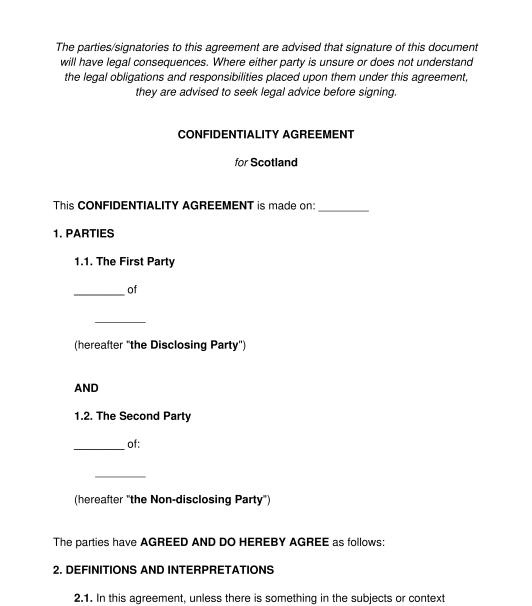 30/09/2025
30/09/2025

Answer a few questions and your document is created automatically.

Your document is ready! You will receive it in Word and PDF formats. You will be able to modify it.

 30/09/2025
30/09/2025
 Word and PDF
Word and PDF
 6 to 8 pages
6 to 8 pages
A confidentiality agreement (also referred to as a non-disclosure agreement/NDA) protects confidential information disclosed between two parties.
It creates enforceable obligations between the parties, namely that they will not disclose or use any confidential information to third parties for any purpose other than that set out in the agreement.
This agreement is designed for use in Scotland. A different agreement can be used where the parties are resident in either England and Wales or Northern Ireland.
A confidentiality agreement may be used in a number of different settings, including in an employment setting or alongside a business transaction.
This kind of agreement can be used to address different types of situations. It can be used where:
This document can be used where the parties to the agreement are resident in Scotland. A different agreement can be used where the parties are resident in either England and Wales or Northern Ireland.
No. It is not mandatory to have a confidentiality agreement attached to another form of agreement. However, a business may use this type of agreement to protect its intellectual property and trade secrets. A confidentiality agreement should only be used when necessary.
This kind of agreement should not:
Before the agreement is signed, the restricted party should be provided with sufficient opportunity to read and understand the terms of the agreement. They should be afforded the opportunity to seek legal advice should they wish to do so. In an employment setting, the restricted party should be able to discuss the terms with a trade union representative.
Either party to the agreement may be a natural person. A natural person who is entering into a legal agreement should have full capacity (meaning that they are of sound mind). Generally speaking, they should be over the age of 16*.
A party may also be a corporate entity with its own legal personality (e.g. a company).
The agreement should only remain in place for a period which is reasonable and necessary to protect the interests of the business. Typically, this will be between 3-5 years. Some information may need to be kept confidential indefinitely (such as important intellectual property or lists of customers).
The parties should sign the agreement in the presence of an independent witness.
If a party is a corporate entity, the party signing the agreement must have the authority to bind the party. Usually, this person will be a company secretary or director of a company, or a member of a Limited Liability Partnership (LLP).
Both parties should retain the final signed version of the agreement.
Each party should sign the agreement in the presence of a witness, who will also sign the agreement. The witness should be over the age of 18, and should not be a party to the agreement.
If one party does not comply with the agreement, the other party may initially send a warning notice to the other party. The other party may also wish to take steps to start court proceedings in the Civil Court. A party may seek an injunction (an order to prevent further information sharing) and damages for any losses incurred.
The agreement should include information to confirm:
The key legal provisions applicable to a confidentiality agreement are:
The Advisory, Conciliation and Arbitration Service (ACAS) provides detailed guidelines about confidentiality agreements in an employment setting.
You fill out a form. The document is created before your eyes as you respond to the questions.
At the end, you receive it in Word and PDF formats. You can modify it and reuse it.
A guide to help you: Signing Documents in England and Wales
Confidentiality Agreement (Scotland) - Sample, template
Country: United Kingdom